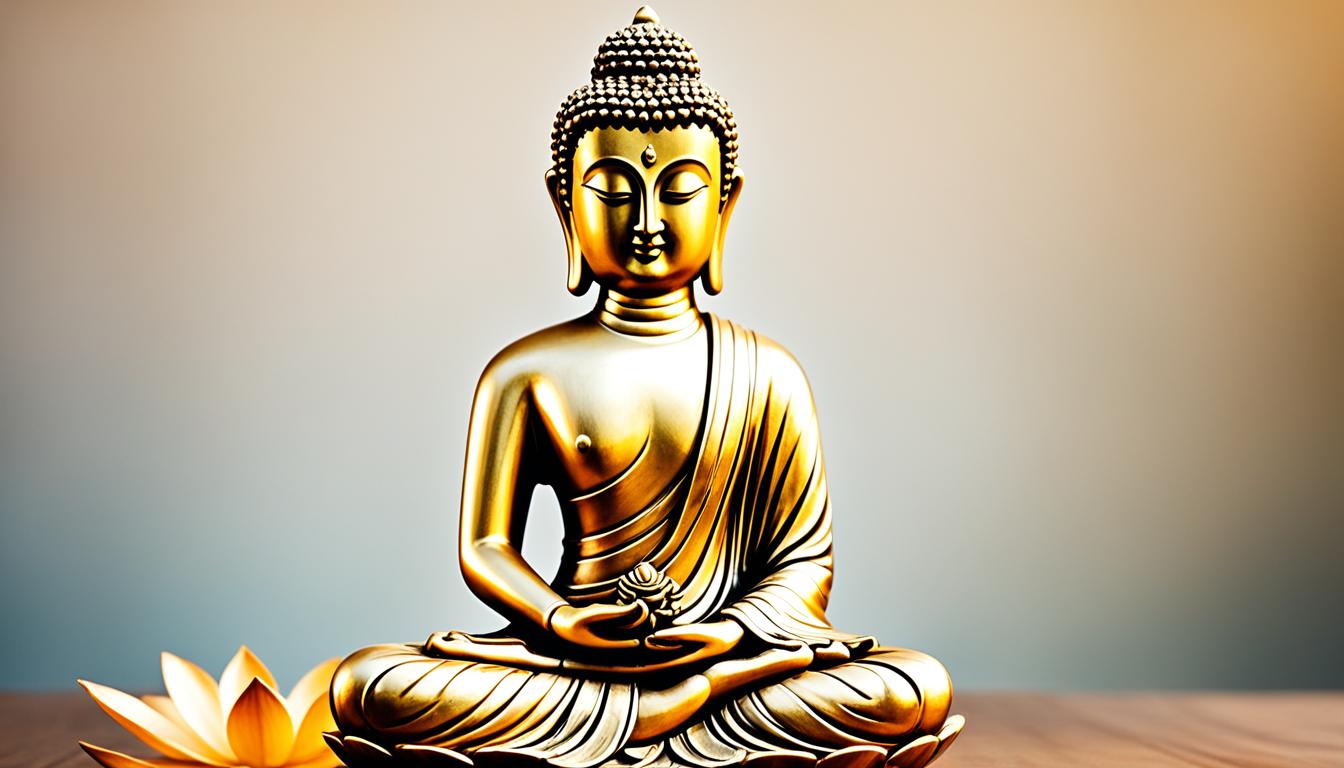“Thousands of candles can be lit from a single candle, and the life of the candle will not be shortened. Happiness never decreases by being shared.”
Welcome to a journey of self-discovery and spiritual enlightenment as we delve into the core belief of Buddhism. Buddhism, one of the world’s major religions, offers profound insights into the nature of existence and the pursuit of happiness. With its emphasis on compassion, mindfulness, and the search for truth, Buddhism provides a path towards personal growth, inner peace, and liberation from suffering.
Key Takeaways:
- The basic belief of Buddhism is that human life is a cycle of suffering and rebirth.
- Buddhists seek to achieve a state of enlightenment, known as nirvana, to escape the cycle of suffering.
- Siddhartha Gautama, also known as the Buddha, was the first person to reach enlightenment and become a teacher.
- The Four Noble Truths are the essence of Buddha’s teachings, explaining the nature of suffering and the path to liberation.
- Karma and rebirth are fundamental concepts in Buddhism, shaping the cycle of existence based on one’s actions.
The Life and Journey of Siddhartha Gautama
Siddhartha Gautama, born in present-day Nepal and India, was a prince during the 5th century B.C.E. His early life was filled with luxury and extravagance, shielded from the harsh realities of the world. However, everything changed when he confronted the inevitable truths of sickness, old age, and death.
This profound encounter ignited a deep curiosity within Siddhartha, leading him on a transformative quest to understand the nature of human suffering. Determined to find answers, he renounced his princely title and embarked on a spiritual journey as a wandering holy man.
For years, Siddhartha practiced various religious disciplines and sought guidance from renowned teachers. Yet, he remained unsatisfied and continued his pursuit of enlightenment. It was during this relentless pursuit that he discovered the Middle Way, a path of balance and moderation.
Finally, after years of dedicated practice, Siddhartha achieved enlightenment while meditating under the Bodhi tree. This profound moment marked the culmination of his spiritual journey and marked the birth of a new era. From that point forward, Siddhartha Gautama was known as the Buddha, meaning “the awakened one.”
Throughout his life, the Buddha’s teachings and his own example inspired countless individuals to seek enlightenment and find freedom from suffering.

The Transformational Moment
Under the shade of the Bodhi tree, Siddhartha Gautama experienced a profound realization that would forever change his path and shape the future of Buddhism. The serene setting provided the perfect backdrop for his deep contemplation, leading to his ultimate enlightenment.
- The Bodhi tree, also known as the Ficus religiosa, is revered as a sacred symbol and a site of pilgrimage for Buddhists.
- This iconic tree is closely associated with the transformative moment in Siddhartha Gautama’s life, where he gained deep insights into the nature of reality.
- His profound realization of the Four Noble Truths and the path to liberation unfolded under the branches of the Bodhi tree.
The image below depicts the serene majesty of the Bodhi tree, evoking a sense of tranquility and the sacredness of Siddhartha Gautama’s enlightenment.

The life and journey of Siddhartha Gautama, from being a prince to becoming the Buddha, serves as an inspirational example of the transformative power of spiritual awakening and the pursuit of enlightenment. His teachings continue to guide and inspire individuals on their own path towards liberation from suffering and the realization of inner peace.
The Four Noble Truths
The essence of the Buddha’s teachings are encapsulated in the Four Noble Truths. These truths provide profound insights into the nature of human existence and the path to liberation.
1. The Truth of Suffering
The first Noble Truth acknowledges that life is characterized by suffering (dukkha). It recognizes that individuals experience physical and emotional pain, dissatisfaction, and dissatisfaction throughout their lives. This suffering can manifest in various forms, including illness, loss, and the inevitable decay of the physical body.
2. The Truth of Desire
The second Noble Truth identifies desire (tanhā) as the root cause of suffering. It explains that attachment, craving, and clinging to worldly desires and pleasures lead to a cycle of discontentment. The insatiable nature of desire perpetuates suffering, as individuals constantly seek external sources of fulfillment that are ultimately impermanent and unsatisfying.

3. The Truth of Enlightenment
The third Noble Truth offers hope amidst suffering, teaching that it is possible to attain enlightenment and end the cycle of suffering. It emphasizes the potential for liberation from suffering and the achievement of a state of profound peace, happiness, and inner freedom. By overcoming desire and cultivating wisdom, individuals can transcend the limitations of existence and awaken to their true nature.
4. The Truth of the Middle Way
The fourth Noble Truth presents the Middle Way as the path to enlightenment. It advocates for avoiding extremes and finding balance and moderation in all aspects of life. This path guides individuals to steer clear of excessive indulgence and severe asceticism, recognizing that both extremes hinder the pursuit of enlightenment. By practicing self-discipline, moral conduct, and mindfulness, one can follow the Middle Way and progress towards liberation.
| Noble Truth | Summary |
|---|---|
| 1. The Truth of Suffering | Life is characterized by suffering and dissatisfaction. |
| 2. The Truth of Desire | Craving and attachment to desires perpetuate suffering. |
| 3. The Truth of Enlightenment | Enlightenment offers liberation from suffering. |
| 4. The Truth of the Middle Way | The Middle Way leads to enlightenment through balance and moderation. |
The Concept of Karma and Rebirth
Buddhism embraces the profound notion of karma, an intricate interplay between actions and consequences that shapes the course of an individual’s life. Karma, widely acknowledged as the foundation of Buddhists’ beliefs and practices, refers to the actions one takes during their lifetime and the ripple effects they create.
According to Buddhist teachings, karma is a universal force that governs the cycle of rebirth. It operates under the principle that good actions engender happiness while bad actions lead to suffering. The concept of karma provides individuals with a framework for understanding the consequences of their thoughts, words, and deeds.
Just as a seed planted in fertile soil sprouts and grows, every action carries its own karmic potential. This potential connects an individual’s past, present, and future experiences, forming a continuous cycle of rebirth. Buddhists believe that upon death, one’s karma determines their next existence.
Within the cycle of rebirth, there are six realms, each offering a unique set of experiences. These realms include the realms of gods, demigods, humans, animals, hungry ghosts, and hell beings. While the gods dwell in realms of pleasure and abundance and the hell beings endure immense suffering, it is the realm of humans that holds the greatest significance in terms of personal growth and liberation from the cycle of rebirth.
In the realm of humans, individuals have the opportunity to cultivate wisdom, compassion, and ultimately achieve enlightenment. This pursuit of enlightenment is the sole means of breaking free from the cycles of rebirth and attaining nirvana, the transcendent state of liberation from suffering.
By recognizing the profound connection between karma and rebirth, Buddhists strive to live in alignment with the principles of moral conduct and ethical responsibility. They seek to generate positive karma through acts of kindness, generosity, and compassion towards all sentient beings, thereby ensuring a favorable trajectory in the cycle of rebirth.

| Realms of Rebirth | Description |
|---|---|
| Gods | Beings who dwell in realms of pleasure and abundance. |
| Demigods | Similar to gods but experience occasional conflicts. |
| Humans | Provides the opportunity for personal growth and enlightenment. |
| Animals | Beings characterized by instinctual behavior and limited awareness. |
| Hungry Ghosts | Suffer from insatiable desires and constant cravings. |
| Hell Beings | Endure immense suffering in realms of intense pain. |
Schools of Buddhism
When it comes to Buddhism, there are three main schools that have developed over time, each with its own unique practices and teachings. These schools are Mahayana Buddhism, Theravada Buddhism, and Vajrayana Buddhism.
Mahayana Buddhism
Mahayana Buddhism is widely practiced in countries such as China, Taiwan, Japan, and South Korea. This school of Buddhism emphasizes the importance of bodhisattvas, enlightened beings who choose to delay their own enlightenment in order to help others achieve liberation. Mahayana Buddhists aspire to follow the example of these bodhisattvas and work towards the well-being and enlightenment of all sentient beings. They believe that liberation can be attained not only by monks and nuns but also by the laity.
Theravada Buddhism
Theravada Buddhism is commonly practiced in countries like Sri Lanka, Thailand, and other Southeast Asian nations. This school of Buddhism focuses on a monastic way of life and places great emphasis on meditation as a means to achieve enlightenment. Theravada Buddhists strive for personal liberation and enlightenment through the practice of ethical conduct, meditation, and deep reflection on the teachings of the Buddha. Monks and nuns play a central role in preserving and propagating the teachings of the Buddha in Theravada communities.
Vajrayana Buddhism
Vajrayana Buddhism is predominantly practiced in Tibet, Nepal, Bhutan, and Mongolia. Also known as Tibetan Buddhism, Vajrayana Buddhism offers a faster path to enlightenment through the use of various transformative practices, including mantras, rituals, and visualizations. This school of Buddhism places a strong emphasis on the guidance and blessings of a qualified spiritual teacher, known as a guru. Vajrayana practitioners aim to harness and transform energy and emotions as a means to realize their inherent Buddha nature and achieve enlightenment in this lifetime.
Overall, these three schools of Buddhism provide different paths and practices for individuals seeking enlightenment and liberation from suffering. Whether you resonate with the compassionate ideals of Mahayana Buddhism, the disciplined meditation practices of Theravada Buddhism, or the transformative methods of Vajrayana Buddhism, there is a path within Buddhism that can guide you on your spiritual journey.
The Importance of Meditation in Buddhism
Meditation plays a vital role in Buddhism, serving as a powerful tool for achieving inner stillness, mindfulness, and ultimately, enlightenment. Through various meditation practices, Buddhists gain insight into the true nature of existence and strive to reach a state of Nirvana.
There are different forms of meditation in Buddhism, each with its own unique approach and benefits. Some practitioners choose to sit quietly in meditation, focusing on their breath or a specific object of contemplation. Others engage in active forms of meditation, such as practicing martial arts or engaging in mindful movement.
A key aspect of Buddhist meditation is cultivating mindfulness, which involves developing a heightened awareness and deep understanding of one’s thoughts, feelings, and actions. Mindfulness allows individuals to observe their inner experiences without judgment, fostering a deeper connection with oneself and the present moment.
Through consistent meditation practice, Buddhists strive to quiet the mind, free themselves from distractions, and attain a state of inner peace and enlightenment. Meditation serves as a pathway to clarity, wisdom, and liberation from the cycle of suffering.
The Benefits of Meditation in Buddhism
Meditation in Buddhism offers a multitude of benefits for practitioners:
- Enhanced mindfulness: Through meditation, Buddhists develop a heightened sense of awareness and attentiveness to the present moment.
- Increased emotional well-being: Regular meditation practice cultivates equanimity, compassion, and loving-kindness, leading to greater emotional balance and well-being.
- Stress reduction: Meditation helps individuals manage stress, anxiety, and negative emotions by promoting relaxation and a sense of inner calm.
- Improved concentration: The focused attention involved in meditation enhances concentration and cognitive abilities, leading to improved mental clarity and productivity.
- Spiritual growth: Deepening one’s meditation practice can lead to profound spiritual experiences, insights, and a deeper connection to one’s true self.
In essence, meditation is a gateway to self-discovery, inner transformation, and the attainment of enlightenment in Buddhism. By nurturing a regular meditation practice, individuals embark on a profound journey of self-exploration and the realization of their highest potential.
Comparison of Different Meditation Practices in Buddhism
| Form of Meditation | Description |
|---|---|
| Sitting Meditation | Practitioners sit quietly, focusing on their breath, a mantra, or a specific object of contemplation. |
| Walking Meditation | Participants engage in slow, mindful walking, focusing on the sensations of each step. |
| Chanting Meditation | Recitation of specific chants or mantras to focus the mind and cultivate inner peace. |
| Metta Meditation | Practitioners cultivate loving-kindness and compassion towards oneself and others through systematic meditation. |
Each form of meditation offers a unique approach to cultivating mindfulness, calming the mind, and nurturing inner growth.
The Teachings of Buddha
The teachings of the Buddha are profoundly impactful and have been passed down through scriptures known as the Tripitaka, or Three Baskets. These scriptures contain the wisdom, sayings, and explanations of the Buddha, providing guidance for those seeking spiritual enlightenment.
The Tripitaka is divided into three sections, or baskets, each serving a specific purpose. The Vinaya Pitaka focuses on rules and regulations for the monastic community, outlining guidelines for discipline and conduct. The Sutta Pitaka comprises discourses and dialogues, conveying the Buddha’s teachings on various subjects. And finally, the Abhidhamma Pitaka delves into profound psychological and metaphysical analysis.
The Tripitaka is a comprehensive compilation of the Buddha’s teachings, providing a roadmap for practitioners to cultivate wisdom, compassion, and liberation from suffering.
In addition to the Tripitaka, Buddhists also follow a set of ethical guidelines known as the Five Precepts. These precepts serve as a framework for leading a virtuous life and ensuring harmony within oneself and the broader community.
The Five Precepts are:
- Refrain from taking life: This precept encourages Buddhists to value and respect all forms of life, promoting non-violence and compassion towards living beings.
- Refrain from taking what is not given: Buddhists are urged to respect the property of others and avoid stealing or taking what does not belong to them.
- Refrain from sexual misconduct: This precept emphasizes the importance of maintaining fidelity and engaging in sexual relationships that are consensual and based on mutual respect.
- Refrain from false speech: Buddhists strive to be truthful in their communication, avoiding deceit, slander, and gossip.
- Refrain from intoxicants: This precept advises against the consumption of substances that cloud the mind and lead to unwholesome actions.
By adhering to these five principles, Buddhists cultivate virtues and create conditions for personal and societal well-being.
The Influence of the Tripitaka and Five Precepts
The Tripitaka and Five Precepts serve as guiding lights for Buddhists, illuminating the path towards enlightenment, inner peace, and compassionate living. Through the study and application of these teachings, individuals gain insights into the nature of reality and develop the virtues necessary for personal transformation.
By upholding the Five Precepts, Buddhists cultivate ethical conduct, fostering harmonious relationships and contributing to a more compassionate society. The Tripitaka, with its vast range of teachings, offers wisdom and guidance for navigating the complexities of life, helping individuals find liberation from suffering and attain enlightenment.
Conclusion
Through its core belief in the cycle of suffering and rebirth, the pursuit of enlightenment, and the practice of mindfulness and compassion, Buddhism offers profound insights for personal growth and societal harmony. By understanding the Four Noble Truths, you gain an awareness of the nature of suffering and the possibility of liberation. Following the Middle Way, a path of balance and moderation, guides you in navigating life’s challenges while avoiding extremes.
Engaging in meditation allows you to cultivate mindfulness and develop a deeper understanding of your thoughts, feelings, and actions. By embracing the teachings of the Buddha, you can find inner peace, transform your perspective, and ultimately achieve liberation from suffering.
Buddhism’s impact extends beyond the individual. It provides valuable guidance to communities worldwide, fostering personal connection and societal harmony. The principles of Buddhism promote compassion, ethics, and empathy, emphasizing the interconnectedness of all beings. By applying these principles in our daily lives, we contribute to a more compassionate and harmonious world.
FAQ
What is the basic belief of Buddhism?
The basic belief of Buddhism is that human life is a cycle of suffering and rebirth.
What are the core beliefs of Buddhism?
The core beliefs of Buddhism include the pursuit of enlightenment and the practice of mindfulness and compassion.
Who was Siddhartha Gautama?
Siddhartha Gautama was a prince who became the Buddha after achieving enlightenment.
What are the Four Noble Truths?
The Four Noble Truths are the essence of Buddha’s teachings and explain the nature of suffering, its cause, and the path to liberation.
What is the concept of karma and rebirth in Buddhism?
Karma refers to the actions one takes in life, which influence their future circumstances and the cycle of rebirth.
What are the different schools of Buddhism?
Buddhism is divided into Mahayana, Theravada, and Vajrayana schools, each with its own practices and teachings.
Why is meditation important in Buddhism?
Meditation allows Buddhists to achieve inner stillness, develop mindfulness, and ultimately reach a state of enlightenment.
What are the teachings of Buddha?
The teachings of Buddha are documented in scriptures like the Tripitaka and include guidelines for ethical conduct known as the Five Precepts.

